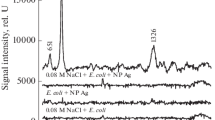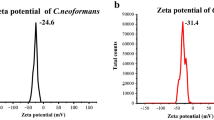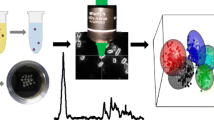Abstract
The article describes a SERS-based method for diagnosis of bacterial infections. Positively charged silver nanoparticles (AgNPs+) were employed for identification of methicillin-resistant Staphylococcus aureus (MRSA). It is found that AgNPs+ undergo self-assembly on the surface of bacteria via electrostatic aggregation. The assembled AgNPs+ are excellent SERS substrates. To prove the capability of SERS to differentiate between S. aureus and other microorganisms, six standard strains including S. aureus 29213, S. aureus 25923, C. albicans, B. cereus, E. coli, and P. aeruginosa were tested. To further demonstrate its applicability for the identification of MRSA in clinical samples, 52 methicillin-sensitive S. aureus (MSSA) isolates and 215 MRSA isolates were detected by SERS. The total measurement time (include incubation) is 45 min when using a 3 μL sample. The method gives a strongly enhanced Raman signal (at 730 cm−1 and 1325 cm−1) with good reproducibility and repeatability. It was successfully applied to the discrimination of the six strain microorganisms. The typical Raman peaks of S. aureus at 730, 1154, 1325, and 1457 cm−1 were observed, which were assigned to the bacterial cell wall components (730 cm−1- adenine, glycosidic ring mode, 1154 cm−1- unsaturated fatty acid, 1325 cm−1- adenine, polyadenine, and 1457 cm−1 for -COO- stretching). S. aureus was completely separated from other species by partial least squares discriminant analysis (PLS-DA). Moreover, 52 MSSA isolates and 215 MRSA isolates from clinical samples were identified by PLS-DA. The accuracy was almost 100% when compared to the standard broth microdilution method. A classification based on latent structure discriminant analysis provided spectral variability directly. Conceivably, the method offers a potent tool for the identification of bacteria and antibiotics resistance, and for studies on antibiotic-resistance in general.

Schematic of the surface-enhanced Raman scattering (SERS) measurements on Staphylococcus aureus (S. aureus) using positively charged silver nanoparticles (AgNPs+). AgNPs+ are adsorbed on the bacterial cell wall by electrostatic attraction. SERS spectra were analyzed by PLS-DA for the identification of Staphylococcus aureus (MRSA) and methicillin-resistant Staphylococcus aureus (MSSA). MRSA isolates were divided into four groups, including R1, R2, R3, and R4. MSSA just includes group S.




Similar content being viewed by others
References
Ning Y, Zou L, Gao Q, Hu J, Lu F (2018) Graphene oxide-based fluorometric determination of methicillin-resistant Staphylococcus aureus, by using target-triggered chain reaction and deoxyribonuclease-assisted recycling. Microchim Acta 185(3):183
Kearns H, Goodacre R, Jamieson L, Graham D, Faulds K (2017) SERS detection of multiple anti-microbial resistant pathogens using nanosensors. Anal Chem 89(23):12666–12673
Wang H, Zhang C, Xing D (2011) Simultaneous detection of Salmonella enterica, Escherichia coli O157:H7, and Listeria monocytogenes using oscillatory-flow multiplex PCR. Microchim Acta 173(4):503–512
Sheikhzadeh E, Chamsaz M, Turner AP, Jager EW, Beni V (2016) Label-free impedimetric biosensor for salmonella typhimurium detection based on poly [pyrrole-co-3-carboxyl-pyrrole] copolymer supported aptamer. Biosens Bioelectron 80:194–200
Alula MT, Krishnan S, Hendricks NR, Karamchand L, Blackburn JM (2017) Identification and quantitation of pathogenic bacteria via in-situ formation of silver nanoparticles on cell walls, and their detection via SERS. Microchim Acta 184(1):219–227
Yong TK, Chen Y, Choi JY, Kim WJ, Dae HM, Jung J (2012) Integrated microdevice of reverse transcription-polymerase chain reaction with colorimetric immunochromatographic detection for rapid gene expression analysis of influenza a h1n1 virus. Biosens Bioelectron 33(1):88–94
Cottat M, D’Andrea C, Yasukuni R, Malashikhina N, Grinyte R, Lidgiguigui N (2015) High sensitivity, high selectivity SERS detection of mnsod using optical nanoantennas functionalized with aptamers. J Phys Chem C 119(27):15532–15540
Preciado-Flores S, Wheeler DA, Tran TM, Tanaka Z, Jiang C, Barboza-Flores M (2011) SERS spectroscopy and SERS imaging of shewanella oneidensis using silver nanoparticles and nanowires. Chem Commun 47(14):4129–4131
Kahraman M, Zamaleeva AI, Fakhrullin RF, Culha M (2009) Layer-by-layer coating of bacteria with noble metal nanoparticles for surface-enhanced Raman scattering. Anal Bioanal Chem 395(8):2559–2567
Li Y, Zhao Q, Wang Y, Man T, Zhou L, Fang X (2016) Ultrasensitive signal-on detection of nucleic acids with surface-enhanced Raman scattering and exonuclease iii-assisted probe amplification. Anal Chem 88(23):11684–11690
Wang R, Xu Y, Wang R, Wang C, Zhao H, Zheng X (2017) A microfluidic chip based on an ITO support modified with ag-au nanocomposites for SERS based determination of melamine. Microchim Acta 184(1):279–287
Xie Y, Xu L, Wang Y, Shao J, Wang L, Wang H (2013) Label-free detection of the foodborne pathogens of Enterobacteriaceae by surface-enhanced Raman spectroscopy. Anal Methods 5(4):946–952
Lan L, Yao Y, Ping J, Ying Y (2017) Recent advances in nanomaterial-based biosensors for antibiotics detection. Biosens Bioelectron 91:504–514
Marsich L, Bonifacio A, Mandal S, Krol S, Beleites C, Sergo V (2012) Poly-l-lysine-coated silver nanoparticles as positively charged substrates for surface-enhanced Raman scattering. Langmuir 28(37):13166–13171
Larmour IA, Faulds K, Graham D (2012) SERS activity and stability of the most frequently used silver colloids. J Raman Spectrosc 43(2):202–206
Munro CH, Smith WE, Garner M, Clarkson J, White PC (1995) Characterization of the surface of a citrate-reduced colloid optimized for use as a substrate for surface-enhanced resonance Raman scattering. Langmuir 11(10):3712–3720
Yang D, Zhou H, Haisch C, Niessner R, Ying Y (2016) Reproducible E. coli detection based on label-free SERS and mapping. Talanta 146:457
Ngola SM, Zhang J, Mitchell BL, Sundararajan N (2010) Strategy for improved analysis of peptides by surface-enhanced Raman spectroscopy (SERS) involving positively charged nanoparticles. J Raman Spectrosc 39(5):611–617
Sanchez-Cortes S, Berenguel RM, Madejón A, Pérez-Méndez M (2002) Adsorption of polyethyleneimine on silver nanoparticles and its interaction with a plasmid dna: a surface-enhanced raman scattering study. Biomacromolecules 3(4):655–660
Berry V, Saraf RF (2010) Self-assembly of nanoparticles on live bacterium: an avenue to fabricate electronic devices. Angew Chem Int Ed 44(41):6668–6673
Zhou H, Yang D, Ivleva NP, Mircescu NE, Niessner R, Haisch C (2012) SERS detection of bacteria in water by in situ coating with ag nanoparticles. Anal Chem 86(3):1525–1533
Sui Z, Chen X, Wang L, Chai Y, Yang C, Zhao J (2005) An improved approach for synthesis of positively charged silver nanoparticles. Chem Lett 34(1):100–101
Lee PC, Meisel D (1982) Adsorption and surface-enhanced Raman of dyes on silver and gold sols. J Phys Chem 86(17):3391–3395
Van LD, Krpetić Ž, Guerrini L, Larmour IA, Dougan JA, Faulds K et al (2012) Positively charged silver nanoparticles and their effect on surface-enhanced Raman scattering of dye-labelled oligonucleotides. Chem Commun 48(66):8192–8194
Dina NE, Zhou H, Colniţă A, Leopold N, Szoke-Nagy T, Coman C (2017) Rapid single-cell detection and identification of pathogens by using surface-enhanced Raman spectroscopy. Analyst 142(10):1782–1789
Gillibert R, Triba MN, Lamy de la Chapelle M (2017) Surface enhanced Raman scattering sensor for highly sensitive and selective detection of ochratoxin A. Analyst 143(1):339–345
Knauer M, Ivleva NP, Liu X, Niessner R, Haisch C (2010) Surface-enhanced Raman scattering-based label-free microarray readout for the detection of microorganisms. Anal Chem 82(7):2766–2772
Wang Y, Lee K, Irudayaraj J (2010) Silver nanosphere SERS probes for sensitive identification of pathogens. J Phy Chem C 114(39):16122–16128
Jarvis RM, Brooker A, Goodacre R (2006) Surface-enhanced Raman scattering for the rapid discrimination of bacteria. Faraday Discuss 132:281–292
Sivanesan A, Witkowska E, Adamkiewicz W, Dziewit L, Kamińska A, Waluk J (2014) Nanostructured silver-gold bimetallic SERS substrates for selective identification of bacteria in human blood. Analyst 139(5):1037–1043
Frey KM, Lombardo MN, Wright DL, Anderson AC (2010) Towards the understanding of resistance mechanisms in clinically isolated trimethoprim-resistant, methicillin-resistant Staphylococcus aureus, dihydrofolate reductase. Journal Struct Bio 170(1):93–97
Lowy FD (2003) Antimicrobial resistance: the example of Staphylococcus aureus. J Clin Invest 111(9):1265–1273
Yun W, Ji Y, Wharfe ES et al (2013) Raman activated cell ejection for isolation of single cells. Anal Chem 85(22):10697–10701
Acknowledgements
This work was supported partially by the National Basic Research Program of China (2015CB755400), the National Natural Science Foundation of China (81430054), Military Medical Prediction Fund of Military Medical University (2016XYY08), the Scientific Foundation of the Southwest Hospital (SWH2017YBXM-16), and Chongqing education committee (CYB17142).
Author information
Authors and Affiliations
Corresponding authors
Ethics declarations
The author(s) declare that they have no competing interests.
Additional information
Publisher’s Note
Springer Nature remains neutral with regard to jurisdictional claims in published maps and institutional affiliations.
Electronic supplementary material
ESM 1
(DOC 36245 kb)
Rights and permissions
About this article
Cite this article
Chen, X., Tang, M., Liu, Y. et al. Surface-enhanced Raman scattering method for the identification of methicillin-resistant Staphylococcus aureus using positively charged silver nanoparticles. Microchim Acta 186, 102 (2019). https://doi.org/10.1007/s00604-018-3150-6
Received:
Accepted:
Published:
DOI: https://doi.org/10.1007/s00604-018-3150-6




